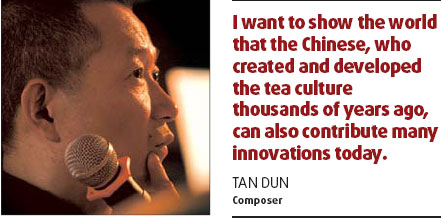Act II contains an interesting scene when Seikyo and Lan travel to southern China to get the Book of Tea. The two enjoy passionate times together and the percussionists blow, tear, rustle and crumple paper to imitate the sounds animals make when they are mating.
An animation, painted by the 88-year-old American-Chinese artist Ding Xiongquan, features various animals who are mating while eight Peking Opera performers dance with large white silk sheets in their hands, with mating animals painted on the sheets. Seikyo and Lan make love under a blanket, surrounded by the dancers and in the shadow of the animation.
It should be an intensely erotic scene, but it is presented in a Chinese, reserved way.
Tan's unique music is complemented by impressive visual scenes to convey his quirky concept of "hearing color and seeing sound".
"In Tea, I explore a new experience of theater," Tan says. "It is an opera of the 21st century. I hope audiences feel that the music is a feast to their eyes as it is pleasant to mine."
Behind Tan is an impressive team, which includes New York-based Chinese director Chiang Ching, artist Ding Xiongquan, German costume designer Patrizia Von Brandstein, Swedish setting designer Thomas Lundgvist and Chinese actress-turned designer Elsa Yeung.
Chiang and Tan have been working together for 26 years and last November, she directed a concert version of Tea at the Stockholm International Composers Festival.
"Since this is the first Chinese version of the opera Tea, we bring many Chinese elements to stage, from the Peking Opera, the 12 symbolic animals to the dragon dance and many others," Chiang says.
Overall, Tan creates a link between the artificial world of theater and the organic world of nature, but the opera can be too cerebral an experience if you attend it without having read the story or without being familiar with the tea ritual.
Nevertheless, Tan is confident and ambitious about his Beijing production.

"First, I write unabashed music and graceful lines for the singers," he says. "Then, I create an interesting experience combining drama, multi-media, installation and organic music.
"I want to show the world that the Chinese, who created and developed the tea culture thousands of years ago can also contribute many innovations today."
(China Daily July 22, 2008)